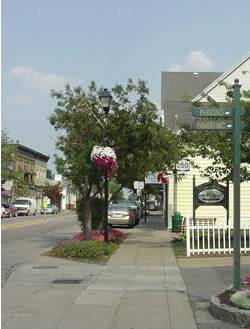Communities are walkable, or pedestrian-friendly, when it is safe, convenient, and interesting to walk from place to place.
Walkable communities offer many potential benefits to residents: health benefits that accrue from more walking and less air pollution; more independence for seniors, youth, and those without cars or unable to drive; reduced transportation costs for households; lower public service costs for taxpayers; more social interaction; and a greater sense of community.
Walkable communities are nothing new to our region. Our successful villages and older neighborhoods and downtowns are highly walkable and accessible to pedestrians.
Establishing Walkable Communities
How can we establish (or reestablish) walkability in a wide range of placessmall towns and larger cities; urban neighborhoods and suburban subdivisions; new developments and old; downtowns and highway corridors?
STEP 1: Recognize the characteristics of pedestrian-friendly environments:
- Buildings are located closer together.
- Buildings are also set close to the street, with fronts opening on to the street.
- Land uses are mixed, providing multiple destinations.
- Streets are narrow and designed for slower speeds.
- Streets are interconnected.
- Blocks are short and lined with sidewalks.
- Streets include benches, attractive trash receptacles, well-marked pedestrian crossings, and facilities for bicycles.
- Parking is on-street or to the rear of buildings.
- Signage and lighting are oriented towards the pedestrian.
Together, these characteristics form the core of a recent urban planning trend known as New Urbanism, a movement that promotes walkable communities.

STEP 2: Recognize that New Urbanism is not a tour de force in itself.
Any pedestrian-friendly initiative must be grounded in the local architectural context and take into account local market conditions. In other words, not every living environment lends itself to all of the elements of the most successful walkable communities, and, therefore, not every neighborhood can, or should, aspire to be like the Village of Pittsford or Park Avenue in Rochester.
Regardless of the built environment, however, improvements to walkability can be made.
In the pedestrian-friendly Village of Webster, a group of organizations called the Webster Community Coalition for Economic Development work together to improve the economic climate and assist with business development. The Coalition is credited with converting a village downtown with many vacant buildings to a downtown where most ground-floor retail and office spaces are fully occupied. The Coalition also works on village aesthetic issues and promotion. The leaders of the Coalition credit a lot of their success to the ability to create collaborative partnerships across the public and private sectors.
STEP 3: Choose the right mix of techniques.
What are some of the general principles communities must be prepared to follow in order to successfully establish or reestablish walkability?
Design is key. Building and site design standards must allow consistent connectivity for pedestrians and vehicles. In addition, a building and design review process must focus on how buildings are located on a site and whether building and site features are both appropriate to the existing context and advance walkability goals. A thoughtful and carefully executed design review process will strengthen the contextual setting while allowing innovation and creativity.
Zoning reflects community goals. All successful pedestrian-friendly communities have zoning which protects and encourages development that is compatible with walkability, such as specific design criteria, a design review process, and supporting ordinances to address, for example, changes to the exteriors of existing buildings, the scale and setbacks of new development, loss of large trees, and the size and layout of streets and parking facilities.
Related planning tools include:
- Community or neighborhood plans that guide development.
- Incentives to encourage infill and redevelopment, including: density bonuses, expedited permitting, reducing or eliminating parking requirements, judicious tax incentives, transfer of development rights, land banking, rehabilitation loan programs, home repair programs, and homeownership training programs.
- Market analysis to help guide public investment and attract private investment.
Selected Resources
Information on community design and zoning, including maintaining neighborhood character and redevelopment strategies and incentives:
Active Living by Design
American Planning Association
Center for Community Progress
Congress for the New Urbanism
National Trust for Historic Preservation Main Street Center
Smart Growth Network
Information on real estate market analysis to attract investment:
Social Compact
Planning and design for pedestrian use and safety:
Institute of Transportation Engineers
Bicycle and Pedestrian Safety Program of the Federal Highway Administration
Walkability focused on youth:
KidsWalk-to-School initiative of the Center for Disease Control and Prevention
Walkability focused on senior citizens:
AARP Livable Communities
National organizations dedicated to walkability:
Pedestrian and Bicycle Information Center
National Center for Bicycling & Walking
Partnership for a Walkable America
America WALKS